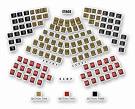 One of the many challenges facing performing arts presenters is figuring out seating plans. With audiences for some artforms such as dance typically booking up to see performances very late — sometimes on the day of performance — trying to work out how much to charge for tickets and how best to fill up premium seats is no easy matter for producers. Mathematicians could spend years working out algorithms to help arts organizations predict how to manage their houses and still the problem wouldn’t be solved.
One of the many challenges facing performing arts presenters is figuring out seating plans. With audiences for some artforms such as dance typically booking up to see performances very late — sometimes on the day of performance — trying to work out how much to charge for tickets and how best to fill up premium seats is no easy matter for producers. Mathematicians could spend years working out algorithms to help arts organizations predict how to manage their houses and still the problem wouldn’t be solved.
I was reminded of this issue a couple of nights ago when I met a friend for drinks before going to see Chanticleer perform a concert at the Conservatory of Music in San Francisco. My friend, who had a complementary ticket to see the performance on account of personal ties to the group, said that she would have to leave our drinks session early and head over to the box office to claim her ticket. She had been told that her ticket would be sold off if she arrived later than 7.45pm. My friend said that this ticket crunch was happening as a result of the fact that a huge group of visiting singers would be in the house that night, leading to a potential scramble at the box office.
By the time the performance started, however, the alleged crunch never materialized. There were dozens of open seats in the orchestra section. And for some reason, the cheaper balcony area was completely full.
I’m not quite sure what happened at the box office. Perhaps fewer visiting singers turned up than was planned. Or maybe the recession priced many people out of the orchestra and into the balcony. But it would have made much more sense for the orchestra seats to have been filled, even at a lower rate, than start the performance with such gaping holes in the auditorium. Why didn’t the house managers invite the balcony crowd down to the orchestra? Also, threatening to sell off comp tickets to audience members who don’t show up by a certain time doesn’t exactly ingratiate an organization to its closest fans when the house isn’t remotely full.
I hear that some innovative ideas are starting to emerge about how to manage to tricky problem of seating to cope with evolving ticket-buying habits. One idea is to have “dynamic seating” where seats in a certain part of an auditorium are sold according to the law of supply and demand — ie, if a show is selling fast, the prices of the tickets go up and vise-versa. Another idea is for presenters to tailor prices to reflect certain kinds of performances. For example, in a piano recital, tickets would be more expensive on the more desirable keyboard-side of the house, because people like to watch the pianist’s fingers on the keyboard. Seats in a normally-viewed-as-premium seating area of the orchestra which don’t have a view of the keyboard would therefore be cheaper.
P.S. The concert itself was mostly wonderful. I could have done without the overly-fast tempo employed during Janequin’s “La Guerre”. Chanticleer made this musical ode to the tumult of warfare sound like a drinking song. But I especially loved the way in which the singers moved between three different liturgical pieces in the second part of the program – two settings of “Veni sponsa Christi” (a plainchant version and one by Palestrina) followed by the 20th century composer Jean Yves Daniel-Lesur’s “Epithalame” from Le Cantique des Cantiques. Although the three pieces were written in entirely different styles and at different times in history, the group managed to find the thread connecting all three. The singers created a seamless unbroken thread of sound that was as thrilling as it was meditative.
